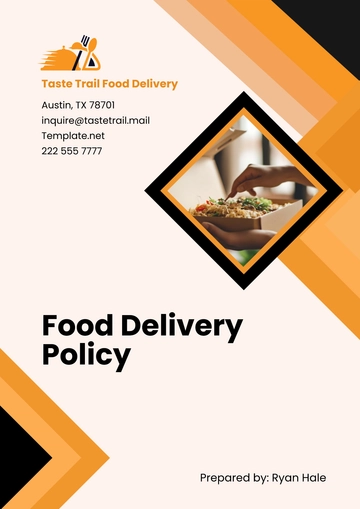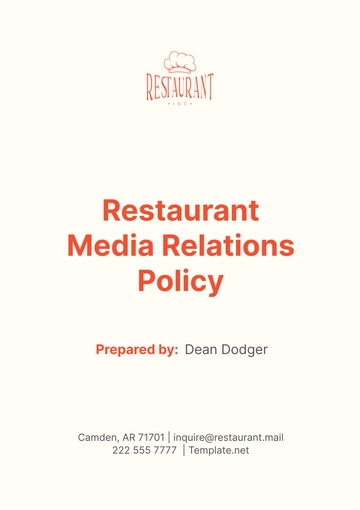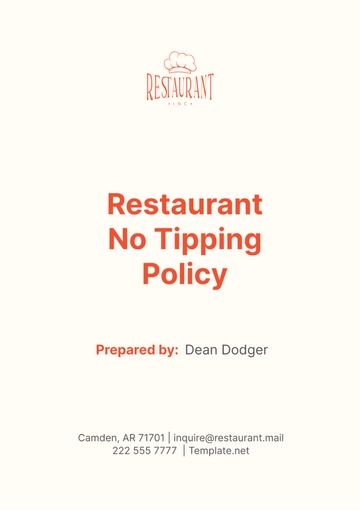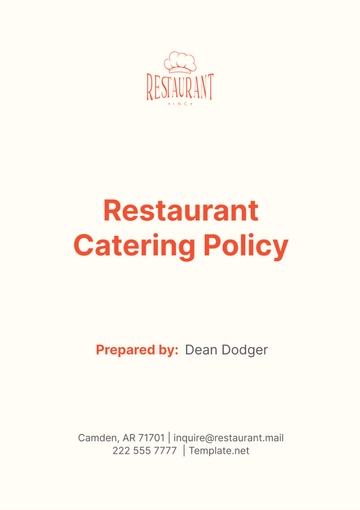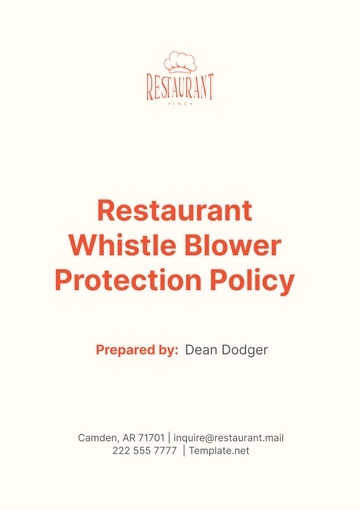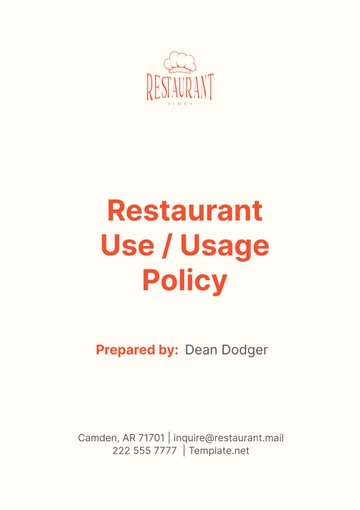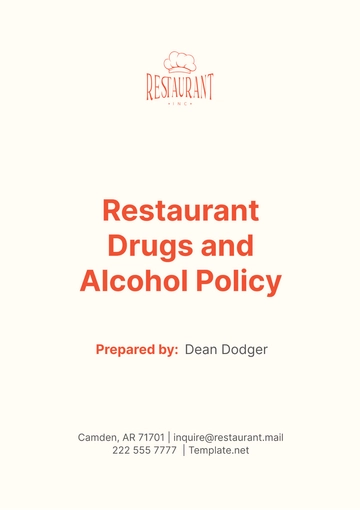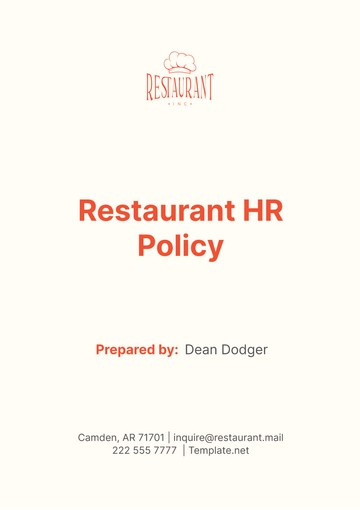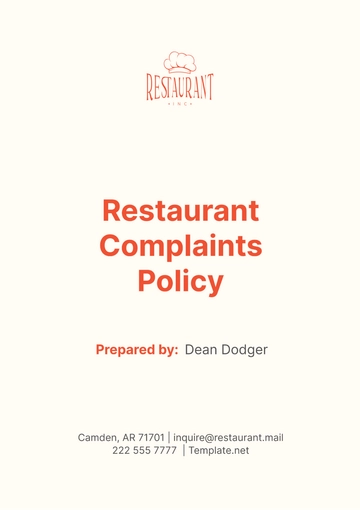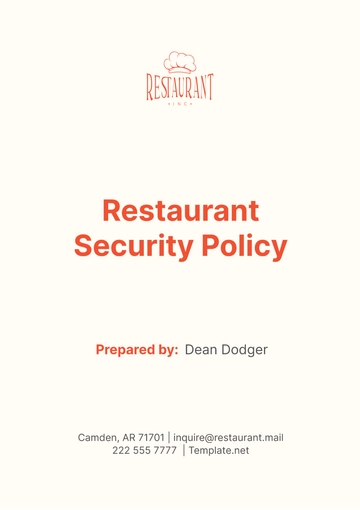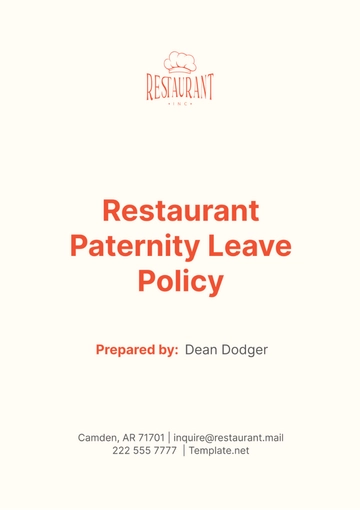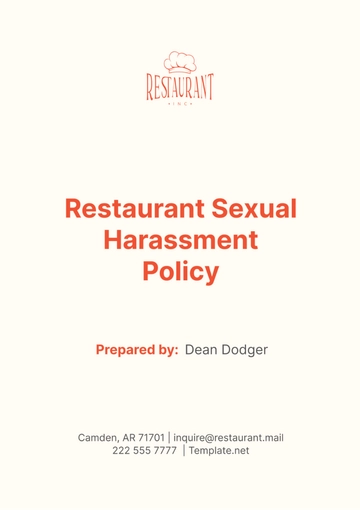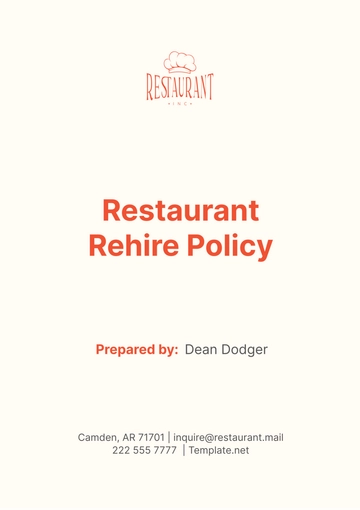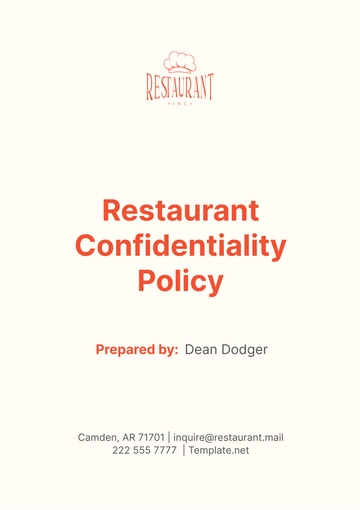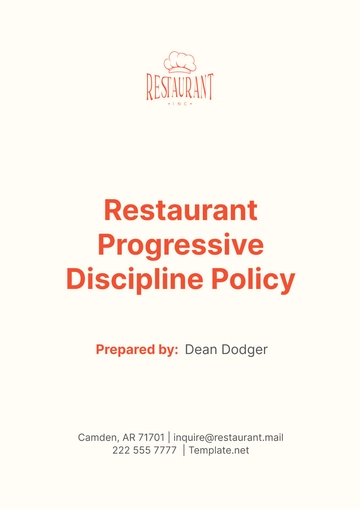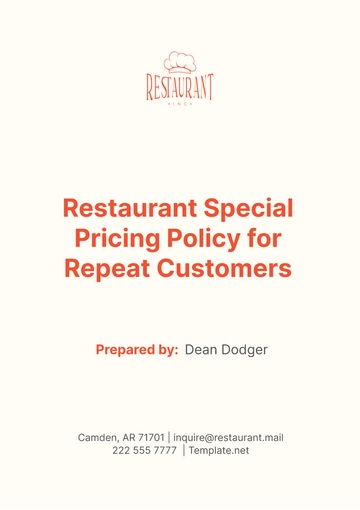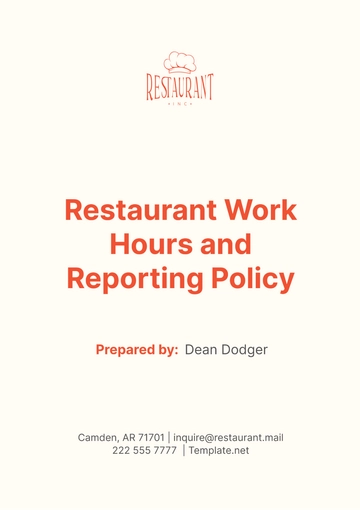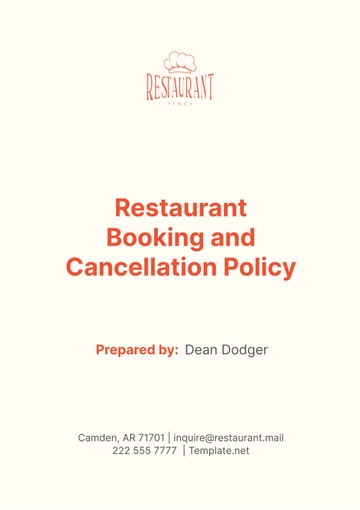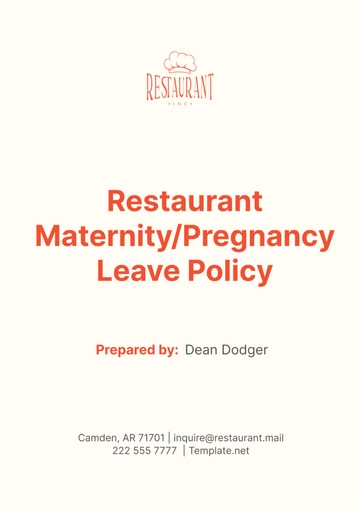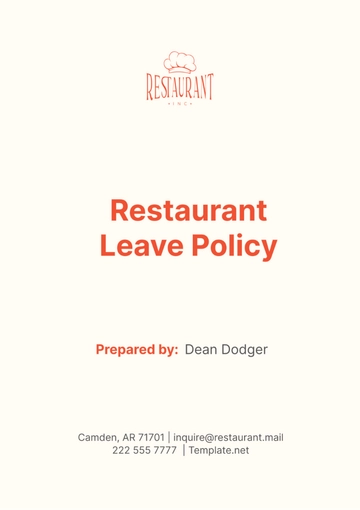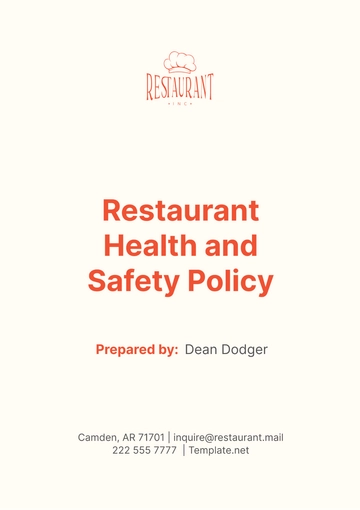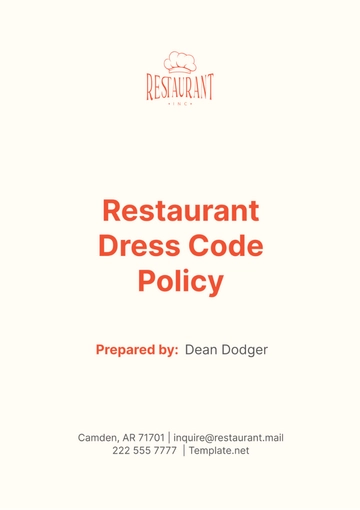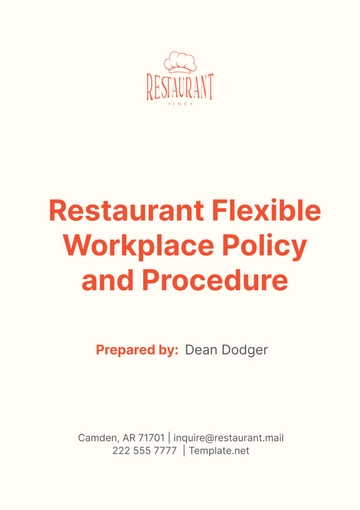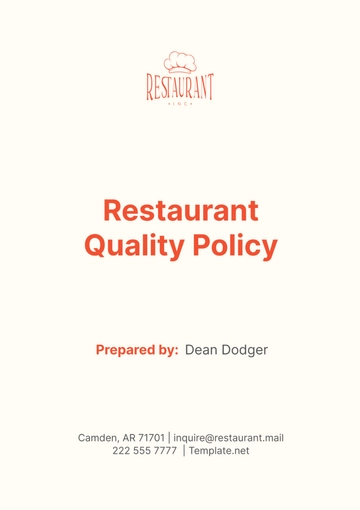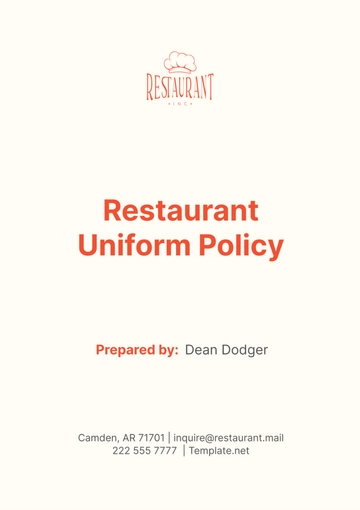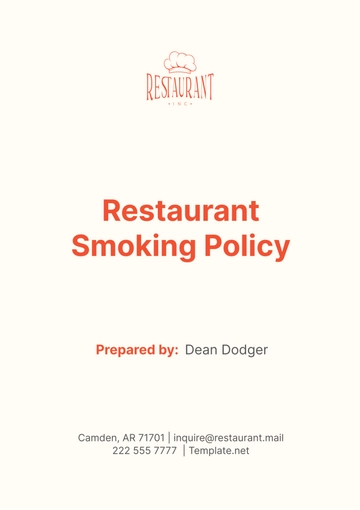Free Restaurant Safety Policy
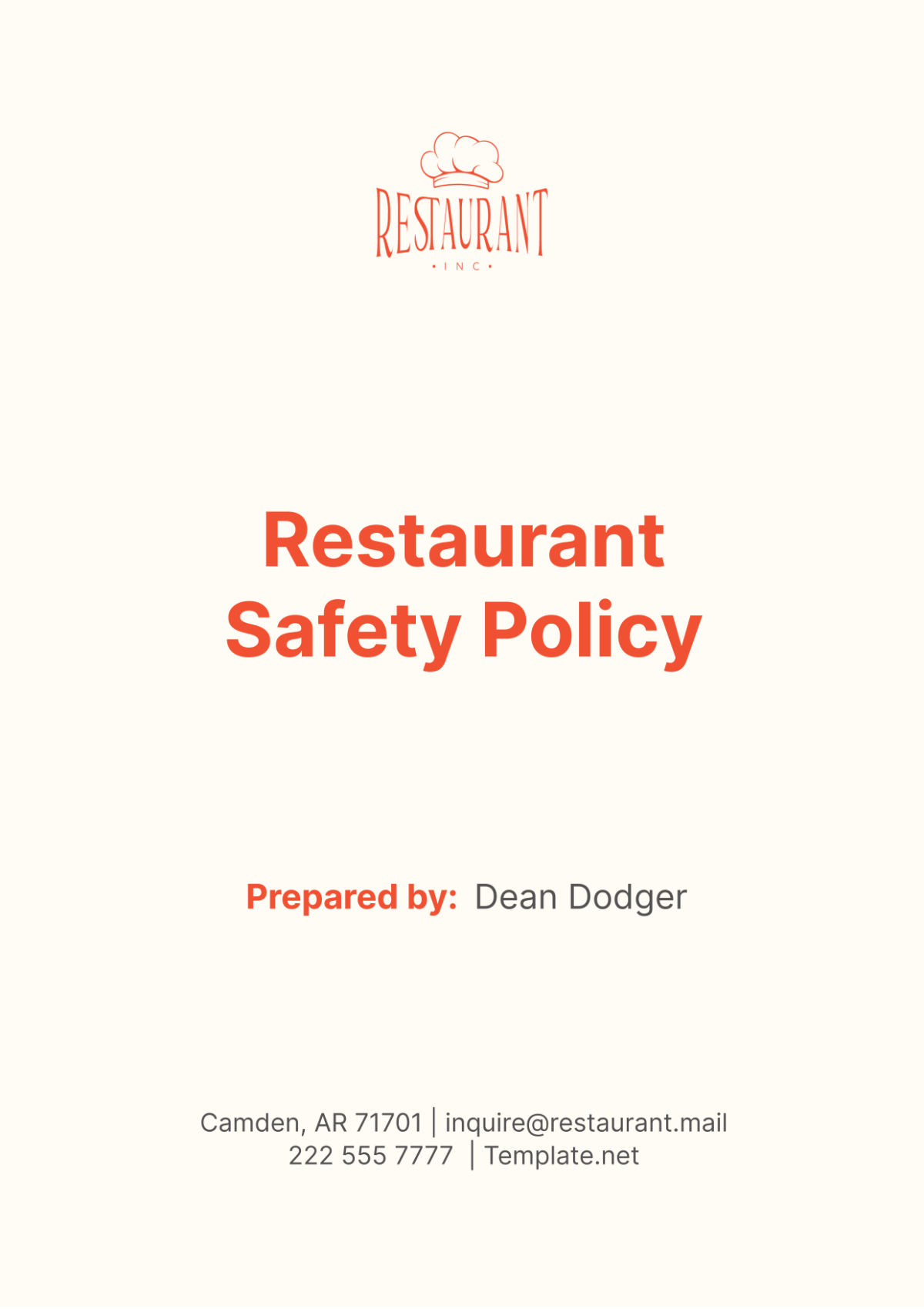
I. Introduction
The safety of our staff and customers is of utmost importance. [Your Company Name]'s Safety Policy has been developed to ensure a safe and healthy environment within our establishment. Compliance with this policy is mandatory for all employees and management to reduce the risk of accidents and enhance the overall safety and wellbeing of everyone within the premises.
A. Purpose
The purpose of this policy is to establish procedures and guidelines to minimize safety hazards and ensure that appropriate measures are in place to handle any emergencies or incidents that may arise. The goal is to maintain a safe working and dining environment at all times.
B. Scope
This policy applies to all employees, contractors, and visitors within the restaurant premises. It covers all aspects of restaurant operations including food preparation, service, sanitation, and maintenance activities.
II. Responsibilities
Responsibilities for safety are shared between management and employees. Clear understanding and adherence to these responsibilities are crucial for maintaining a safe work environment.
A. Management Responsibilities
Effective management is crucial for maintaining a safe work environment. The following responsibilities outline the proactive role that management should take in ensuring safety compliance and promoting a culture of safety within the organization.
Ensuring Compliance: Management must ensure compliance with safety regulations and the company's safety policy. This includes staying updated with regulations and ensuring all employees are trained accordingly.
Providing Training and Resources: Management is responsible for providing adequate training and resources for safety practices. This includes regular safety training sessions and access to necessary safety equipment.
Conducting Inspections: Regular safety inspections and audits should be conducted by management to identify and address any safety hazards.
Maintaining a Safe Environment: Management must maintain a safe and clean environment for employees and customers. This includes proper maintenance of equipment and facilities.
Reporting and Investigating Incidents: Management should promptly report and investigate any safety incidents to prevent recurrence and improve safety measures.
B. Employee Responsibilities
Employees play a crucial role in maintaining a safe work environment through their actions and adherence to safety protocols.
Complying with Protocols: Employees are responsible for complying with all safety protocols and procedures. This includes following guidelines for handling equipment and chemicals.
Participating in Training: Employees must actively participate in safety training sessions to stay informed about safety practices and procedures.
Reporting Unsafe Conditions: Employees should report any unsafe conditions or incidents to management immediately to prevent accidents and injuries.
Maintaining Cleanliness: Employees are responsible for maintaining cleanliness and organization at their workstations to prevent accidents and promote a safe working environment.
Using Safety Equipment: Employees must use safety equipment and personal protective equipment properly to protect themselves and others from hazards.
Emergency Preparedness: Employees should be familiar with emergency procedures and participate in drills to ensure a quick and effective response in case of an emergency.
Health and Wellness: Employees are encouraged to maintain their health and wellness to reduce the risk of accidents and injuries in the workplace.
III. General Safety Procedures
Adherence to these general safety procedures is vital to ensuring a safe environment for both employees and customers in our restaurant.
Emergency Exit Procedures: Emergency exits must be clearly marked and unobstructed at all times to ensure a quick and safe evacuation in case of an emergency.
Fire Safety Equipment: Fire extinguishers and first aid kits must be accessible and regularly checked to ensure they are in working condition.
Handwashing Techniques: Proper handwashing techniques must be followed by all staff, especially in food preparation areas, to prevent the spread of germs and foodborne illnesses.
Caution Signs: Caution signs must be used in wet or hazardous areas to alert employees and customers to potential dangers.
Food Safety Protocols: Food safety protocols, including proper storage and cooking temperatures, must be adhered to at all times to prevent foodborne illnesses and ensure the safety of our customers.
IV. Emergency Procedures
In the event of an emergency, following these procedures is crucial for the safety and well-being of everyone in the restaurant.
Remaining Calm: Remain calm and follow instructions from management and emergency personnel to ensure a swift and organized response to the emergency.
Evacuation: If necessary, evacuate the premises using the nearest emergency exit and move to the designated assembly area.
Accountability: Account for all employees and customers to ensure everyone has safely evacuated the premises.
First Aid: Provide first aid if trained and qualified to do so, following proper procedures to assist those in need.
Reporting: Report the incident to emergency services and management immediately to ensure a timely and effective response to the emergency.
V. Accident Reporting and Investigation
Accident reporting and investigation are crucial for identifying the root causes of accidents and implementing corrective measures to prevent future incidents.
Reporting Accidents: All accidents, no matter how minor, must be reported to management immediately. An accident report form should be completed to document the incident.
Investigating Incidents: Management will investigate all reported accidents to determine the causes and contributing factors. This may involve interviewing witnesses, reviewing CCTV footage, and inspecting the scene of the accident.
Implementing Corrective Measures: Based on the findings of the investigation, management will implement corrective measures to prevent similar accidents in the future. This may include additional training, changes to procedures, or equipment upgrades.
Reviewing Safety Protocols: Regular reviews of safety protocols should be conducted to ensure they are effective and up-to-date. Any necessary changes should be communicated to all employees promptly.
Safety Culture: Fostering a culture of safety is essential for preventing accidents. Encouraging open communication and proactive reporting of hazards can help create a safer work environment for everyone.
A. Accident Reporting Contacts
In the event of an accident, knowing who to contact is crucial. The following table provides the key contacts for reporting accidents and initiating the investigation process.
Contact | Phone Number | |
|---|---|---|
Immediate Supervisor | [Number] | [Email] |
Safety Officer | [Number] | [Email] |
Human Resources | [Number] | [Email] |
Health and Safety Manager | [Number] | [Email] |
Instructions:
Immediately inform your immediate supervisor about the accident.
If your supervisor is unavailable, contact the Safety Officer or the Human Resources Department.
The Health and Safety Manager should be notified for any serious or critical incidents.
Provide as much detail as possible about the accident, including date, time, location, and nature of the incident.
VI. Training
Training is a crucial component of ensuring a safe workplace. All employees must receive comprehensive training on safety procedures to prevent accidents and injuries.
A. Training Topics
Fire Safety and Evacuation Drills: Employees should be trained on fire safety procedures and participate in regular evacuation drills to ensure they can safely evacuate in case of a fire.
Proper Use of Safety Equipment: Training should cover the proper use of safety equipment, such as fire extinguishers and safety harnesses, to prevent accidents.
Personal Protective Equipment (PPE): Employees should be trained on the importance of using PPE, such as gloves and safety goggles, and how to properly use and maintain it.
Food Safety and Sanitation Practices: Training should cover food safety practices, including proper storage, handling, and cooking techniques, to prevent foodborne illnesses.
First Aid and Emergency Response: Employees should receive training in first aid and CPR to be able to respond effectively in case of an emergency.
B. Schedule of Training
Training Topic | Frequency | Duration |
|---|---|---|
Fire Safety and Evacuation Drills | Annually | 1 hour |
Proper Use of Safety Equipment | As needed | 30 minutes |
Food Safety and Sanitation Practices | Biannually | 1 hour |
First Aid and Emergency Response | Every 2 years | 2 hours |
C. Ongoing Training
Ongoing training ensures that employees remain up-to-date with safety procedures and practices.
Regular Refreshers: Regular refresher courses should be conducted to reinforce safety procedures and address any updates or changes in protocols.
New Employee Orientation: All new employees should receive comprehensive safety training as part of their orientation process to familiarize them with safety procedures from the start.
Supervisor Training: Supervisors should receive additional training to effectively manage safety in the workplace and ensure compliance with safety regulations.
VII. Policy Review
This policy will be reviewed annually to ensure its effectiveness and compliance with any new regulations or industry standards. Updates and changes to the policy will be communicated to all employees.
For any questions or further information regarding this policy, please contact [Your Company Name]'s Safety Department at [Your Company Number].
Thank you for your cooperation and commitment to maintaining a safe and healthy environment within our restaurant.
- 100% Customizable, free editor
- Access 1 Million+ Templates, photo’s & graphics
- Download or share as a template
- Click and replace photos, graphics, text, backgrounds
- Resize, crop, AI write & more
- Access advanced editor
Ensure a safe environment for employees and patrons with the Restaurant Safety Policy Template, exclusively available on Template.net. This template offers a framework for establishing safety protocols in your restaurant. With easy editing features in our Ai Editor Tool, create a safety policy that promotes a culture of safety.
You may also like
- HR Policy
- Restaurant Policy
- Company Policy
- Accounting Policies and Procedures
- Website Policy
- Privacy Policy
- Safety Policy
- School Policy
- IT and Software Policy
- Law Firm Policy
- Construction Policy
- Interior Design Policy
- Travel Agency Policy
- Education Academic Policy
- Security Policy
- Real Estate Policy
- Expense Policy
- Software Policy
